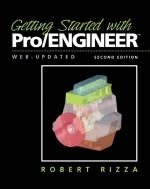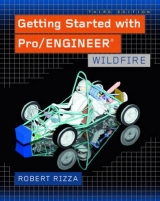
Getting Started with Pro/ENGINEER
Peachpit Press Publications (Verlag)
978-0-13-061303-5 (ISBN)
- Titel erscheint in neuer Auflage
- Artikel merken
For courses in Pro/ENGINEER—
Computer-Aided Drawing.
Originating from an introductory engineering graphics and computer aided design (CAD) course, this text uses examples from different areas in the engineering sciences. Through the use of tutorials, exercises, and examples, the author shows students how to communicate design ideas graphically. Updated to be compatible with the latest Pro/ENGINEER 2001 release.
Robert Rizza is a Professor of Mechanical Engineering at Tri-State University, where he teaches courses in mechanics and computer-aided design. A native of Chicago, he received the Ph.D. degree from the Illinois Institute of Technology. He has worked on a diverse range of engineering projects including projects from the railroad, bioengineering, and aerospace industries. His current research interests are in fracture of composite materials, repair of cracked aircraft components, and loosening of prostheses.
(NOTE: Each chapter begins with an Introduction and Objectives and concludes with Additional Exercises.)
1. Getting Acquainted with the Pro/E Interface.
The Pro/E Interface. Part Files and Pro/E. Changing the Orientation of a Model. Solid Models. The Use of Mapkeys. Printing. Summary and Steps for Using Various Interface Options.
2. Basic Model Construction with Features.
Parts and the Sketcher. Symbols Used in the Regeneration Process. The Use of Relations. Changing the Units of a Part. More Complicated Sections. Thin Sections. Conic Sections. Summary and Steps for Using the Sketcher.
3. Models with Multiple Features.
Datum Planes and Multiple Features. Datum Planes Added by the User. Start Parts and Templates. Summary and Steps for Using User-Defined Datums.
4. Adding Holes to Base Features.
Adding Holes in Pro/E. Summary and Steps for Adding Holes.
5. Options That Remove Material: Cut, Neck and Shell.
Adding a Cut. Adding a Neck. Using the Shell Option. Summary.
6. Options That Add Material: Flange, Rib and Shaft.
Flanges. Ribs. Shafts. Summary.
7. Options That Speed Up Model Construction: Pattern, Copy, Group, Mirror Geom, and UDF.
Using the Pattern Option. Using the Group Option. The Copy Option. The Mirror Geom Option. User-Defined Features. Summary.
8. Fillets, Rounds and Chamfers.
The Use of Rounds and Fillets. Chamfers. Summary.
9. Datum Points, Axes, Curves and Coordinate Systems.
Constructing a Datum Axis. Datum Coordinate Systems. Datum Points. Datum Curves. Summary.
10. The Revolve Option.
Revolved Sections. Summary and Steps for Using the Revolve Option.
11. Feature Creation with Sweep.
The Sweep Option. Helical Sweeps. Sweeps Along a Datum Curve. Summary and Steps for Using the Sweep Option.
12. Blends.
The Blend Option. Swept Blends. Summary and Steps for Creating Blends.
13. Some Options for Managing Features.
The Redefine Option. The Reorder and Reroute Option. Layers and Features. Suppress and Resume. The Resolve Option. Summary and Steps for Using the Options in This Chapter.
14. Cosmetic Features.
Pro/E Cosmetic Options. Summary and Steps for Adding Cosmetic Features.
15. Quilts and Some Tweak Options.
Adding a Draft to a Base Feature. Ears. The Lip Option. Quilts. Summary and Steps for Using the Options Considered in This Chapter.
16. The Drawing Mode.
Drawings and Formats. Adding Dimensions and Text to a Drawing. Auxiliary Views and Pro/E. Summary.
17. Creating a Section.
Creating and Placing a Section. Summary and Steps for Creating a Section.
18. Adding Tolerances to a Drawing.
Adding Traditional Tolerances to a Drawing. Geometric Dimensioning and Tolerancing. Summary and Steps for Adding Tolerances to a Drawing.
19. Assemblies and Working Drawings.
Creating an Assembly File. Creating Parametric Assemblies. Assemblies with Multiple Parts. Creating Parts in the Assembler. Additional Constraints. Exploded Assemblies. Adding Offset Lines to Assemblies. Adding an Assembly to a Drawing. Bill of Material (BOM) and Balloons. Summary and Steps for Dealing with Assemblies.
20. Engineering Information and File Transfer.
Defining and Assigning Material Properties. Model Analysis. The Measure Option. IGES File Transfer. Summary and the Steps for the Options of this Chapter.
Appendix.
Bibliography.
Index.
| Erscheint lt. Verlag | 7.11.2001 |
|---|---|
| Verlagsort | Berkeley |
| Sprache | englisch |
| Maße | 202 x 254 mm |
| Gewicht | 778 g |
| Themenwelt | Informatik ► Weitere Themen ► CAD-Programme |
| ISBN-10 | 0-13-061303-7 / 0130613037 |
| ISBN-13 | 978-0-13-061303-5 / 9780130613035 |
| Zustand | Neuware |
| Haben Sie eine Frage zum Produkt? |
aus dem Bereich



